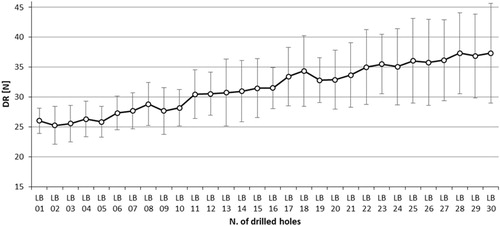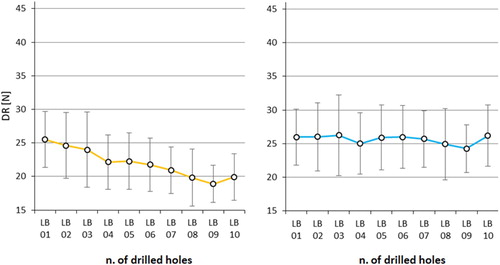Introduction
Sandstone has been traditionally exploited worldwide for building stone because of its widespread availability. This class of materials comprises a range of stones with variable mineralogical, microstructural and mechanical properties. Upon prolonged exposure in the outdoor conditions typical for built heritage, and depending on the specific environmental threats, sandstone surfaces can undergo severe deterioration (Doehne and Price Citation2011; Siegesmund and Snethlage Citation2011).
A thorough understanding of the inherent stone properties, of the damage mechanisms involved in such processes, and of the extent of the changes are fundamental to planning an effective conservation strategy. These factors are also essential for assessing the efficacy of treatments for cleaning, consolidation and surface protection. The characterization of compositional, microstructural and mechanical properties of porous materials in laboratory conditions includes a broad spectrum of diagnostic techniques. Similarly, a detailed investigation of the effects, location and extent of damage can be achieved through a number of laboratory methodologies, ranging from the macro- to the nano-scale. The options for testing the properties of materials and for testing the performance of conservation treatments on-site are more limited, however, if the aim is to reduce the need for sampling and invasive approaches. Moreover, the integration of laboratory- and field-based methodologies, and the correlation of the results, can be challenging.
To this end, the sandstone conservation project has aimed to develop an integrated strategy to evaluate the effects of conservation treatments on a range of sandstones, combining standardized laboratory tests and on-site portable techniques. The overall goal of the research is to implement operative guidelines to support conservation professionals to choose the most appropriate and effective conservation treatments for sandstones. A selection of sandstones with different mineralogical and microstructural features was identified during the first stage of the research for the comparative evaluation of standard characterization protocols. An integrated strategy for the assessment of a reference consolidation treatment was then implemented, with particular reference to water absorption, surface hardness (Desarnaud et al. Citation2019) and mechanical features. The water absorption behavior and the mechanical cohesion of the stone substrates are among the most relevant factors in the evaluation of the consolidation treatments and are critical parameters to be investigated on-site.
This paper presents selected results from the comparative evaluation of on-site methods for the quantification of capillary water absorption and reports on the correction methodology for the mechanical characterization through drilling resistance measurements (DRMS). DRMS is currently one of the most effective techniques for minimally invasive, on-site investigation of the mechanical cohesion profiles with depth. It therefore informs the extent and progression of decay and, upon treatment, it can effectively estimate the efficacy and penetration of the consolidation. Careful processing and correction of the data, however, are needed for a reliable interpretation of the results. The overall integrated strategy for the assessment of conservation treatments is the subject of on-going research and will be described in future publications.
Methodology
Four sandstones representative of widely used materials in European and North American built heritage were selected on the basis of mineralogy, porosity classes (according to Siegesmund and Snethlage Citation2011), pore size distribution, clay content and presence of expanding clays.
The selected sandstones are:
Ohio (USA), medium-grained sandstone with quartz, silica cementation, minor muscovite, non-expanding clay content including kaolinite and illite, average porosity around 20%;
Locharbriggs (UK), medium-grained sandstone with quartz, silica cementation, minor feldspar, iron oxides, clay content including smectite and kaolinite, average porosity around 20%;
Stanton Moor (UK), medium-grained and poorly sorted sandstone with quartz, silica and calcite cementation, non-expanding clay content including kaolinite and illite, average porosity around 12%;
Prague (Msěné, Czech Republic), coarse-grained with quartz and silica cementation and high amount of non-expanding clays, average porosity in the range 26–30%.
The integrated assessment strategy is summarized in .
Table 1. Testing methodologies for the integrated assessment strategy.
Assessment of physical properties (water absorption)
Karsten tube (KT) and Mirowsky tube (MIR) are commonly employed methodologies for the non-invasive evaluation of water absorption behavior of porous substrates. More recently, the contact sponge test method (CSM) has also been introduced and validated for on-site application (Vandevoorde et al. Citation2013). CSM provides a reliable alternative and can overcome some of the limitations of the former methods (time-consuming set-up for measurement, and need to seal the material to isolate the tested surface). Comparison of the field-based method with the traditional laboratory water absorption test by capillarity (CA) for short absorption times (90 minutes) provided a good correlation between the results of the Ohio, Locharbriggs and Stanton Moor sandstones (data not shown). Among the tested methods, MIR shows the highest spread of data and it overestimates the water absorption values with respect to the other techniques. This can be related to the specific testing conditions, such as the type of contact of the sponge with the surface, and to the possible presence of air bubbles (Vandevoorde et al. Citation2013). The particularly high porosity and permeability of Prague sandstone produces a very fast water absorption rate even at relatively short testing times, and does not lead to reliable measurements using KT or CSM.
The long-term absorption behavior of Ohio, Locharbriggs and Stanton Moor sandstones is reported in . KT is better able to reproduce the absorption trend of the standard laboratory methodology, especially during the early stages of testing and for low-porous substrates (such as Stanton Moor). Also in this case, MIR provides more scattered results as indicated by the rather irregular absorption trends of Ohio sandstone. The long term absorption behavior seems also to be influenced by the contact area of the testing methodologies: the smaller areas (as for MIR) generally lead to higher final absorption values.
Correction methodology for the assessment of mechanical properties through DRMS
DRMS has become part of the field-based toolkit for the assessment of mechanical cohesion and of the performance of consolidation treatments, with applications ranging from natural stone materials to mortars and plasters (Ferreira Pinto and Rodrigues Citation2008; Jroundi et al. Citation2014; Rodrigues et al. Citation2018). A correction for all artifacts not directly related to the inherent mechanical resistance of the substrate has to be performed after the testing. One of the most commonly used methods to correct the wear effect of the diamond drill bits for increasing drilling length is based on the use of an essentially non-abrasive and highly homogeneous artificial stone material (ARS) (Tiano et al. Citation2000). Some limitations in this approach have been highlighted, indicating that the correction of the DRMS curves by means of an external reference material may lead to unsatisfactory results if the abrasiveness of the reference material is different from the one being tested (Rodrigues and Costa Citation2004).
The specific abrasiveness of the Locharbriggs sandstone is responsible for significant wear during the testing. The DRMS results for this quartz-rich stone clearly show an increase in the average drilling resistance values (DR) and also an increase in the standard deviation after successive measurements of the same material ().
Figure 2. Average drilling resistance and standard deviation values of Locharbriggs sandstone for 30 measurements with the same drill bit without correction (set 1).

To assess the validity of the ARS correction method, an alternative correction was also applied by using Locharbriggs stone as a reference. The results for the corrected DRMS data obtained in both cases () show that the ARS method leads to an increasing overcorrection of the drilling resistance, whereas the use of the sandstone itself for correction provides more consistent average values. In the case of Prague sandstone (data not shown) both correction methods produce similar results, with a very limited improvement in the data when using the stone itself for correction. Therefore, the most suitable correction method is one that is highly stone-specific, and should be carefully considered.
Conclusions
Selected laboratory and field-based methodologies commonly used for investigating water absorption behavior were studied on four sandstones. Investigations were part of an integrated strategy for stone characterization and to assess the performance of conservation treatments. Both KT and CSM provided reliable results for low- and medium-porosity substrates, whereas MIR results were less consistent. In very porous materials (Prague sandstone) water absorption rates were extremely fast and neither KT nor CSM were suitable.
The DRMS measurements on two sandstones were differently affected by the specific abrasiveness of the substrates. The correction for drill bit wear is a key factor and has to be carefully evaluated, according to the stone characteristics. The commonly used ARS correction led to unsatisfactory results on Locharbriggs sandstone, whereas the use of the same stone as correction material provided more consistent drilling resistance values. For Prague sandstone, both correction methods proved satisfactory. This aspect is particularly critical during the on-site investigation of naturally aged substrates, which are generally characterized by a higher variability in terms of mechanical cohesion, and the assessment of consolidated substrates.
There is a need for additional data to build a comprehensive toolkit of methods that can be used by conservators for the assessment of the performance of treatments on sandstone. On-going research is therefore focusing on the definition of suitable accelerated ageing protocols, as well as on the investigation of consolidated substrates, with particular reference to the influence of the curing conditions on the overall efficacy and penetration of the consolidants.
Supplemental Material
Download MP4 Video (409.7 KB)Disclosure statement
No potential conflict of interest was reported by the author(s).
References
- Desarnaud, J., K. Kiriyama, B. Bicer Simsir, K. Wilhelm, and H. Viles. 2019. “A Laboratory Study of Equotip Surface Hardness Measurements on a Range of Sandstones: What Influences the Values and What do They Mean?” Earth Surface Processes and Landforms 44 (7): 1419–1429. doi: 10.1002/esp.4584
- Doehne, E. F., and C. A. Price. 2011. Stone Conservation: An Overview of Current Research. Los Angeles: J. Paul Getty Museum Publications.
- Ferreira Pinto, A. P., and J. Rodrigues. 2008. “Stone Consolidation: The Role of Treatment Procedures.” Journal of Cultural Heritage 9: 38–53. doi: 10.1016/j.culher.2007.06.004
- Jroundi, F., M. T. Gonzalez-Muñoz, A. Garcia-Bueno, and C. Rodriguez-Navarro. 2014. “Consolidation of Archaeological Gypsum Plaster by Bacterial Biomineralization of Calcium Carbonate.” Acta Biomaterialia 10 (9): 3844–3854. doi: 10.1016/j.actbio.2014.03.007
- Rodrigues, J., and D. Costa. 2004. “A New Method for Data Correction in Drill Resistance Tests for the Effect of Drill Bit Wear.” International Journal for Restoration 10: 1–18.
- Rodrigues, J., A. P. Ferreira Pinto, R. Nogueira, and A. Gomes. 2018. “Consolidation of Lime Mortars with Ethyl Silicate, Nanolime and Barium Hydroxide. Effectiveness Assessment with Microdrilling Data.” Journal of Cultural Heritage 29: 43–53. doi: 10.1016/j.culher.2017.07.006
- Siegesmund, S., and R. Snethlage. 2011. Stone in Architecture. Properties, Durability. Berlin: Springer.
- Tiano, P., C. Filareto, S. Ponticelli, M. Ferrari, and E. Valentini. 2000. “Drilling Force Measurement System, a New Standardisable Methodology to Determine the ‘Superficial Hardness’ of Monument Stones: Prototype Design and Validation.” International Journal for Restoration of Buildings and Monuments 6: 115–132. doi: 10.1515/rbm-2000-5460
- Vandevoorde, D., V. Cnudde, J. Dewanckele, L. Brabant, M. de Bouw, V. Meynen, and E. Verhaeven. 2013. “Validation of In Situ Applicable Measuring Techniques for Analysis of the Water Adsorption by Stone.” Procedia Chemistry 8: 317–327. doi: 10.1016/j.proche.2013.03.039


